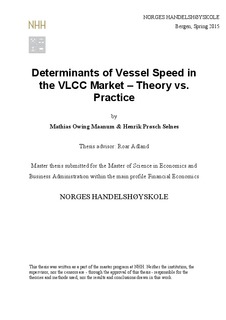| dc.description.abstract | A widely accepted relationship in optimal speed theory is that speeds of vessels respond
positively to changes in freight rates and negatively to changes in bunkers. In this thesis we
analyse how this hypothesis corresponds to what is actually practiced by market participants.
In addition, an important contribution of this thesis is to examine how vessel specific and
operational specific variables affect speed in practice. The analysis is based on the
theoretical speed optimization models of Ronen (1982), and utilizes a comprehensive panel
dataset with observed average daily speed of 607 VLCCs1 in the period from Jan 2013 to
Feb 2015. By applying a random effects panel data model, we are not only able to explain
the variations within one vessel over time, but also variations between vessels. The empirical
analysis shows considerable differences in how speed responds to changes in explanatory
variables for the laden and the ballast leg. For the ballast leg, we find significant
relationships between freight, bunkers and speed, in line with theory, but less in magnitude
than theoretical models suggest. Conversely, for the laden leg we find no evidence for any
relationship between speed and macro variables. Our analysis suggests that financing costs
and the cost distribution among charterers and owners create split-incentive problems for VC
contracts, leading to the discrepancies between theory and practice. The findings can also be
caused by a larger share of the fleet sailing on TC contracts than first anticipated. Further, we
find only slight evidence that vessel specific factors may have an influence on the speed
decision. Cargo owners with operational control of the vessels are shown to have other speed
incentives than traditional shipowners, with more emphasis on cargo value and the sourcing
of cargo. Our findings substantiate that before introducing market-based measures to reduce
emissions, regulating authorities should fully understand the true speed incentives of the
market participants. | nb_NO |
